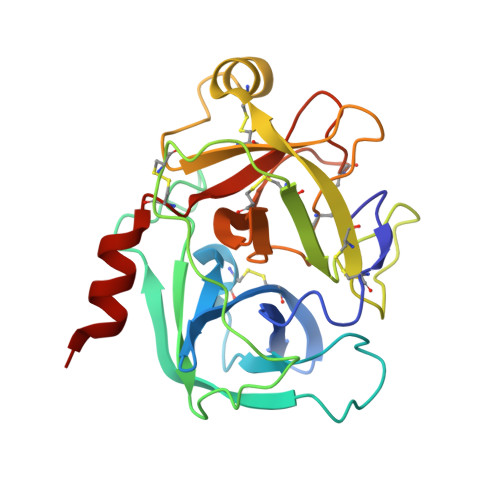Kallikrein 5 inhibitors identified through structure based drug design in search for a treatment for Netherton Syndrome.
White, G.V., Edgar, E.V., Holmes, D.S., Lewell, X.Q., Liddle, J., Polyakova, O., Smith, K.J., Thorpe, J.H., Walker, A.L., Wang, Y., Young, R.J., Hovnanian, A.(2019) Bioorg Med Chem Lett 29: 821-825
- PubMed: 30691925
- DOI: https://doi.org/10.1016/j.bmcl.2019.01.020
- Primary Citation of Related Structures:
6QH9, 6QHA, 6QHB, 6QHC - PubMed Abstract:
Netherton syndrome (NS) is a rare and debilitating severe autosomal recessive genetic skin disease with high mortality rates particularly in neonates. NS is caused by loss-of-function SPINK5 mutations leading to unregulated kallikrein 5 (KLK5) and kallikrein 7 (KLK7) activity. Furthermore, KLK5 inhibition has been proposed as a potential therapeutic treatment for NS. Identification of potent and selective KLK5 inhibitors would enable further exploration of the disease biology and could ultimately lead to a treatment for NS. This publication describes how fragmentation of known trypsin-like serine protease (TLSP) inhibitors resulted in the identification of a series of phenolic amidine-based KLK5 inhibitors 1. X-ray crystallography was used to find alternatives to the phenol interaction leading to identification of carbonyl analogues such as lactam 13 and benzimidazole 15. These reversible inhibitors, with selectivity over KLK1 (10-100 fold), provided novel starting points for the guided growth towards suitable tool molecules for the exploration of KLK5 biology.
Organizational Affiliation:
GlaxoSmithKline R&D, Medicines Research Centre, Gunnels Wood Road, Stevenage, Hertfordshire SG1 2NY, UK. Electronic address: gemma.v.white@gsk.com.
















